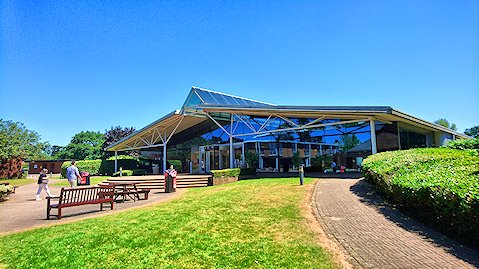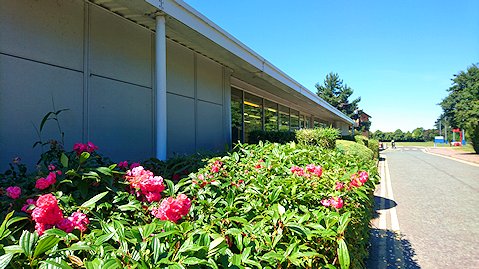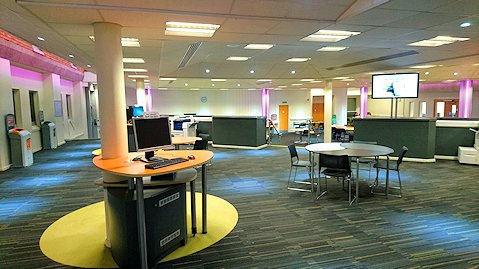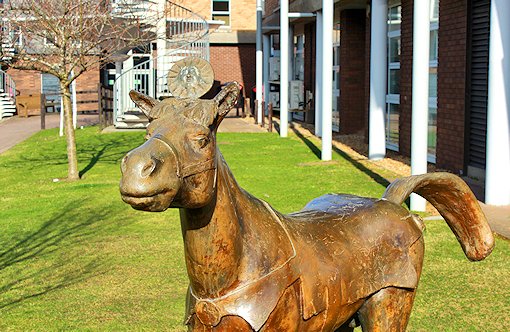Introduction to Park and the PCM project
Page last updated: May 2025
Park Campus Memories (PCM) is a voluntary tribute project for devotees of the former beautiful, popular University of Northampton (UON) Park Campus, Boughton Green Road, on the northern edge of Northampton, UK. 60 acres of partly-wooded parkland. A place of mature trees, attractive shrubs, statues, grass fields, rabbits, squirrels and badgers, with interesting and spacious modern buildings, excellent and varied facilities, a lovely supportive atmosphere and a great feel and vibe.
Whether you are a former or current student or member of staff, a local resident or an interested party, you are very welcome! Please do consider joining our friendly Facebook group!
What happened to Park?
The majority of was sold to Persimmon Homes in 2018, with nearly all of the buildings subsequently demolished, plants torn up and some trees felled. The land is currently being redeveloped for residential housing. Eventually there will be over 800 dwellings, with over half now built and / or occupied. A new campus, Waterside, was constructed just off the Bedford Road, near Becket's Park and the River Nene, which opened in summer 2018.
Two sections of Park were retained by UON - the 1990s East Halls area (renamed Boughton Green Road Halls, and since as Scholars Green Student Village) because there wasn't enough new accommodation at Waterside (due to financial cutbacks to the plans). The halls are still in use but, instead of a five-minute walk to lectures, students now face a 30-minute or more bus journey across town. A 2018-constructed shop is also located on the site. In addition, the Gallagher Sports Field, over the public footpath from the former main Park site, still belongs to the university.
What does PCM do, how did it start and who runs it?
The project is a collection of photography, video footage, scanned documents - rescued, loaned or donated - and other knowledge related to Park Campus - from before, during and after its time as a seat of learning, though chiefly from the college / university era. Our raison d'être is to help preserve and promote the memory of Park, offering free online resources and guidance on the subject.
The project was begun by former undergraduate and student campus tour guide (2000-03), James Lund. Despairing at the plans for the destruction of Park, James realised that he could do something positive about the situation using his skills. Inspired by a project to document the demise of most of the BBC Television Centre in London - and the subsequent successful tribute / fan Facebook groups - in 2017, James began to document Park in photos and video! The PCM project was born!
In 2018, the university gave formal permission for photography, and James worked closely with long-serving member of Estates staff, Matthew Waite, who kindly provided access to usually off-limits areas. In the last weeks of Park, James was able to assist Matthew and his team with a number of very important tasks, such as helping to rescue and sort a large number of documents, and save many plans and papers relating to the history of the site.
The project has grown and envolved from the straightforward documenting of Park, through rescuing items, scanning documents and lobbying the university. 'There are so many stories to tell about the project,' says James. 'People have said I should write a book! I have tales ranging from the wonderful and heartwarming, to the sad and the shocking, the bizarre to the amusing, the mundane to the amazing! I have also met people at all levels of the university. There have been some lovely folk but, sadly, I have also had to deal with some unpleasant attitudes too.' James has also worked alongside the demolition and construction teams, who have been very helpful and supportive to the project.
A second key volunteer is Oliver Hunter, former student (1993-96) and member of staff (1996-98) who has also taken photographs and digitised content. Together with others, James and Oliver work 'for the love of Park' and the benefit of PCM forum members.
PCM is completely independent of the university, and we often lobby UON on our members behalf, as well as to try to convince the institution of the need to be interested in its heritage (there isn't much talk about Park at the uni nowadays!). For example, our biggest success so far has been to convince UON to pay to extract and move the large gold disc mosaic / concrete borough arms of Northampton, that was formerly on the front of Holdenby (Main Building). Without our input, this iconic artwork would surely have been destroyed in the demolition. Sadly, since it's arrival at Waterside in April 2019, the university has not progressed matters. For a while, building materials were stored on top of the four sections. We continue to lobby UON on the matter.
How long had Park been open?
Planned in the late 1960s, Park Campus opened in autumn 1972 as the home of Northampton College of Education (NCE) - a purpose-built teaching centre. The cost of the new college was £882,789 (over £10 million in 2021).
"Northampton College of Education represents an entirely new venture which nevertheless has links with the past. When it welcomed its first year students in September 1972 they joined a student body formed by a merger of the Kirkby Fields College of Education, Liverpool, and the Northampton Annexe of the City of Leicester College of Education.
New members of staff were appointed, but many were transferred from the older institutions.
Students thus enjoy a curriculum which emerges from a combination of well-founded traditions and the vigour and adventurousness associated with a new enterprise. The College is a mixed College of 600 students at present and will grow to 800 students in September 1974."
(NCE prospectus for 1975 entry, published in summer 1974)
Following the 1975 NCE merger with the local colleges of art and technology at Avenue Campus*, Nene College was created. With degree awarding powers, the name changed to University College Northampton (UCN) in 1999 and then University of Northampton (UON) in 2005.
During the course of 46 years, new facilities were added and expansion continued - particularly in the 1990s. The number of subjects increased and, over the decades, thousands of people studied at Park, visited for events or training, business functions or got married on site - the conference centre was licenced for weddings! The old Park isn't fully gone yet either - as stated, some current students are still in residence in the surviving halls.
* Avenue closed in 2020 and most of it was sold for property development in 2021.
What was on the site before a college?
The land was once part of one of the king’s deer hunting parks. King’s Park was around 450 acres in size and enclosed by a stone wall. In 1235 an order was given to stock the park with deer - 20 bucks and 68 does. By 1560 it was said that there were few or no oak trees left in the park, and the remaining wood was mostly thorn bushes. The trees would have been cut down for fires or building work.
In 1576, Sir Christopher Hatton (who later became Lord Chancellor) obtained a grant in fee of the custody of the park with the herbage and pannage - the monarch gave Sir Christopher the right to own and manage the park, and to allow his livestock to graze the land.
Over the following centuries, the land passed through different families. In 1871 it was bought by Northampton brewers, Phipps, who demolished an existing house and built a plain brick version, as well as Moulton Park Farm.
In October 1879, Northampton's St. Andrews Hospital proposed using the house and nearby farm for their patients - people with mental health problems who might work outside rather than being confined to a hospital. The patients lived at various buildings on the site. At one point, Home Farm and a kitchen garden produced all the fruit and vegetables for the hospital.
By the late 1960s, St. Andrew's wanted to raise money for a new hospital wing, so sold their farm to the council, which then allocated the site for the new NCE. It was hoped to be able to incorporate the exisiting buildings, but they were found to be badly affected by dry and wet rot, so had to be demolished.
When did the idea of moving come about?
From 2012, Vice Chancellor Nick Petford, championed and spearheaded a plan for the university to move to a new site, as part of a regeneration of land to the southeast of the town centre. Six years later, the majority of Park was sold for £40 million to housing developer, Persimmon Homes and, after a huge moving process, the handover was on 1st November 2018. The stated cost of Waterside was £330 million - chiefly funded by loans, with a repayment period of over 40 years! The move also co-incided with 'Active Blended Learning' - a move to online teaching in many areas. In addition, staff now had to 'hot desk' in open plan offices, as well as start paying for car parking.
And were the changes popular among staff and students?
Not in our experience. We have spoken with many tens of current staff at different levels in the organisation, together with students, alumni and former staff too. From these conversations, and posts in our forum, we can say that the sale / move was very unpopular. We only found a handful of staff in favour. The changed conditions and distance to the new campus were cited as reasons why some employees had resigned. We have anecdotal evidence that some continuing students (started pre-2018) were unhappy with Waterside, preferring Park.
Why did the uni sell and move?
So many people have asked us that question! Why indeed? Why didn't UON build on its previous huge investment in Park, gradually repurposing or replacing old Park buildings deemed ripe for change? That would be a fiscally prudent move, gradually redeveloping an established site with plenty of space to work.
Environmental reasons have been cited, though what about the impact of the move, and the huge waste of resources that we witnessed in the final months of Park and through the demolition phase. It is worth noting that many of the buildings had been constructed in the previous 25 years - the most recent in 2012!
We gave UON an opportunity to explain their rationale and published the response in our Facebook group. Here is a copy:
"The way in which we teach and students learn is changing. In order to remain competitive and relevant in an evolving education environment, the University must provide new interactive learning practices and a transformational student experience.
The University of Northampton's Park and Avenue campuses were not only ageing and costly to maintain, but also unsuited to the way 21st Century students learn. As a consequence, the campus increasingly became the reason students would decline an offer to study with us.*
Following a review, the bold decision to create a new single campus was taken, and in May 2013 the Board of Governors took the unanimous decision to relocate closer to Northampton town centre, to a new location by the banks of the River Nene. For the first time, HM Treasury guaranteed the £231.5 million bond to fund the campus build – reflecting its confidence in the significance of this large-scale development. In addition, the University has worked in partnership with Northamptonshire County Council and Northampton Borough Council to secure £60 million of funding through the Public Works Loan Board.
Waterside will have a fundamental positive impact on the town and its economy. It brings a 58 acre derelict site back to life and kick-starts development in Northampton's Enterprise Zone. It will embrace its riverside setting and create an exciting new destination for Northampton."
*Source: Decliners’ surveys carried out by Marketing
(University of Northampton spokesman, January 2019)
PCM takes issue with various points in the above, such as why ask the views of people who didn't want to be at Park? Why not ask the people who did want to be there, and find out what attracted them to the institution? (the pretty campus?)
The university is still not on one site, as it rents premises opposite Waterside, The Development Hub, as well as having property by the railway station, at Northampton General Hospital and additional halls near the town centre, as well as those still at Park. Currently, it still owns a building at Avenue too.
Here are two 2015 quotes for comparison with the above:
'State-of-the-art facilities... To ensure you get the very best, we have invested millions of pounds in facilities and buildings on both campuses. [Park and Avenue]'
(University of Northampton 2015 prospectus, page 7)
'Our safe, friendly campuses provide an ideal student environment, with the social energy and convenience of an active urban life set within a charming, leafy setting. We have invested in resources and our excellent facilities provide everything you need right on your doorstep.'
(University of Northampton 2015 prospectus, page 17)
So what changed between 2015 to 2018? Were there actually other reasons or factors for the move - perhaps not all in the best interests of the university?
What happened at Park after the 1st Nov 2018 handover?
Construction of new roads and houses began on the front field. This area was chosen as no demolition was required. The former main student car park became a materials and plant storage area, with the Silverstone building becoming the site office. In January 2019, demolition began, and Park's lovely and familiar buildings began to disappear forever. To give you a scale of the work, it took nine months for the bulk of the demolition to be completed. PCM photographed and videoed through this sad era, and continues to document the site as the house building progresses.
So PCM has become popular?
Indeed it has! We knew there was a lot of love for Park, but have been truly overwhelmed by the success of our tribute Facebook group. We launched an hour before the site handover, and within four months, membership had passed 2,000 - a great vote of confidence in the project! In addition, we also quickly exceeded the official UON alumni group total! (sadly, that forum closed in 2020) In terms of numbers, we achieved in five months what had taken the university five years! James explains: 'Out of the awfulness of the move and destruction has come something truly wonderful - PCM! New friendships have been made, and old ones re-established, we've helped saved artifacts, raised money for charity and shared so many memories of a very special place. We've made a difference for the better!'
As well as students, staff, alumni and past employees, the group has welcomed local residents and others interested parties, including site demolition and construction workers!
With the sale of Park's sister campus, Avenue, in 2021, the team launched a new venture, Avenue Campus Memories, with an associated Facebook group! Click here for the forum
Why is the PCM website being designed in stages?
As a voluntary project, with no outside funding, the team has to fit PCM duties around their normal work and other activities. The sheer scale of the project means that it will take a significant amount of time to sort, review, edit and produce the planned content - including this website, which is produced 'in house'. We think it is best to make available what we have achieved thus far, and as soon as possible. There are some great things to come!
We would be delighted to see and scan your Park photographs and site-related documents - such as promotional material, students' union magazines and staff newsletters. Please check our three downloads pages to see what we have already. Your item may bring great pleasure to us and others! Please get in touch!
Best wishes
The PCM Team
Background images:
1. Delapre and Naseby, 2018
2. Fawsley and the Restaurant, 2018
3. View from back of Grendon, towards Dance Studio, 2018
4. Back Field with Yelvertoft, Kelmarsh and the Pavilion, 2018
5. Cottesbrooke C126 lecture theatre, 2018
6. Senate with Waterside brochure, 2017
7. Dance Studio, 2018
8. Holdenby (Main Building) HLT 2 lecture theatre, 2018
9. Main Entrance and Reception Building, 2018
PCM Homepage
.
 The award-winning restaurant, pictured 2018
The award-winning restaurant, pictured 2018

The Leather Conservation Centre in 2018
Main outlets for the work of PCM:
This website
Features a growing collection of relevant material available to download for free
Facebook group
Includes a monthly batch of 12 images, as well as other albums of pictures. There is the chance for people to comment, exchange views and memories, as well as reconnect with old friends or colleagues.

Just one of the many areas in the large library, 2018
 UON staff at work in the Silverstone building in 2018
UON staff at work in the Silverstone building in 2018

The original 1971/72 Northampton coat of arms in concrete on mosaic on the front of Holdenby, 2019
The academic institutions based at Park Campus
1972-1975
Northampton College of Education (NCE)
1975-1999
Nene College
(from 1988 officially Nene College Higher Education Corporation)
1999-2005
University College Northampton (UCN)
(officially University College Northampton Higher Education Corporation)
2005-present (halls only since 2018)
University of Northampton (UON)
(officially University of Northampton Higher Education Corporation)
Head of the college / university
1971-1989
Principal (1971-1975), Director (1975-1989)
Dr. Eric Ogilvie
1989-2002
Director (1989-1999), Rector (1999-2002)
Dr. S. Martin Gaskell
2002-2010
Rector (2002-2005), Vice Chancellor (2005-2010)
Mrs Ann Tate
2010-2022
Vice Chancellor
Prof. Nick Petford
2022-
Vice Chancellor
Prof. Anne-Marie Kilday
 Impressive, interesting and quirky library infill detail, 2018
Impressive, interesting and quirky library infill detail, 2018

The glorious and popular bronze Sun Horse sculpture in 2018
Background: One of the Cottesbrooke building's two showcase lecture theatres, 2018
A promotional brochure about Waterside, held in front of the Park Senate in 2017
Background: The fabulous Dance Studio in Holdenby (Main Building), 2018

Two of the three double-quad East Halls, each containing around 300 en suite bedrooms, 2017
Background: HLT2 - one of three lecture theatres in the Holdenby building, 2018
 An example of one of the many smaller seminar and lecture rooms in Cottesbrooke, home of the Northampton Business School (later a faculty). Photo taken in 2018.
An example of one of the many smaller seminar and lecture rooms in Cottesbrooke, home of the Northampton Business School (later a faculty). Photo taken in 2018.




 UON staff at work in the Silverstone building in 2018
UON staff at work in the Silverstone building in 2018
 Impressive, interesting and quirky library infill detail, 2018
Impressive, interesting and quirky library infill detail, 2018

 An example of one of the many smaller seminar and lecture rooms in Cottesbrooke, home of the Northampton Business School (later a faculty). Photo taken in 2018.
An example of one of the many smaller seminar and lecture rooms in Cottesbrooke, home of the Northampton Business School (later a faculty). Photo taken in 2018.